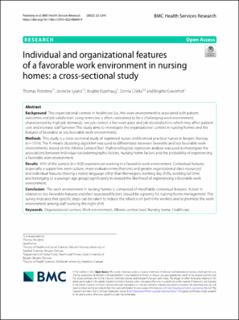| dc.contributor.author | Potrebny, Thomas | |
| dc.contributor.author | Igland, Jannicke | |
| dc.contributor.author | Espehaug, Birgitte | |
| dc.contributor.author | Ciliska, Donna | |
| dc.contributor.author | Graverholt, Birgitte | |
| dc.date.accessioned | 2022-10-25T13:28:53Z | |
| dc.date.available | 2022-10-25T13:28:53Z | |
| dc.date.created | 2022-10-15T12:22:16Z | |
| dc.date.issued | 2022-10-10 | |
| dc.identifier.issn | 1472-6963 | |
| dc.identifier.uri | https://hdl.handle.net/11250/3028226 | |
| dc.description.abstract | Background: The organizational context in healthcare (i.e., the work environment) is associated with patient outcomes and job satisfaction. Long-term care is often considered to be a challenging work environment, characterized by high job demands, low job control, a fast work pace and job dissatisfaction, which may affect patient care and increase staff turnover.This study aims to investigate the organizational context in nursing homes and the features of favorable or less favorable work environments.
Methods: This study is a cross-sectional study of registered nurses and licensed practical nurses in Bergen, Norway (n = 1014). The K-means clustering algorithm was used to differentiate between favorable and less favorable work environments, based on the Alberta Context Tool. Multilevel logistic regression analysis was used to investigate the associations between individual sociodemographic factors, nursing home factors and the probability of experiencing a favorable work environment.
Results: 45% of the sample (n = 453) experienced working in a favorable work environment. Contextual features (especially a supportive work culture, more evaluation mechanisms and greater organizational slack resources) and individual features (having a native language other than Norwegian, working day shifts, working full time and belonging to a younger age group) significantly increased the likelihood of experiencing a favorable work environment.
Conclusion: The work environment in nursing homes is composed of modifiable contextual features. Action in relation to less favorable features and their associated factors should be a priority for nursing home management. This survey indicates that specific steps can be taken to reduce the reliance on part-time workers and to promote the work environment among staff working the night shift. | en_US |
| dc.language.iso | eng | en_US |
| dc.publisher | BMC | en_US |
| dc.rights | Navngivelse 4.0 Internasjonal | * |
| dc.rights.uri | http://creativecommons.org/licenses/by/4.0/deed.no | * |
| dc.title | Indivdual and organizational features of a favourable work environment in nursing homes: a cross-sectional study | en_US |
| dc.type | Journal article | en_US |
| dc.type | Peer reviewed | en_US |
| dc.description.version | publishedVersion | en_US |
| dc.rights.holder | Copyright 2022 the authors | en_US |
| dc.source.articlenumber | 1244 | en_US |
| cristin.ispublished | true | |
| cristin.fulltext | original | |
| cristin.qualitycode | 2 | |
| dc.identifier.doi | 10.1186/s12913-022-08608-9 | |
| dc.identifier.cristin | 2061620 | |
| dc.source.journal | BMC Health Services Research | en_US |
| dc.identifier.citation | BMC Health Services Research. 2022, 22, 1244. | en_US |
| dc.source.volume | 22 | en_US |

